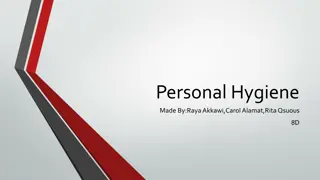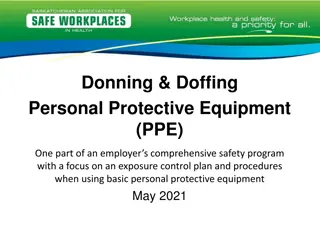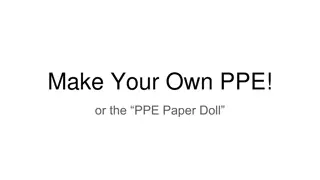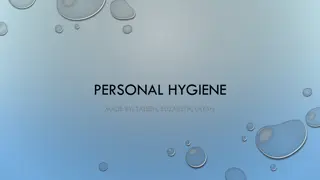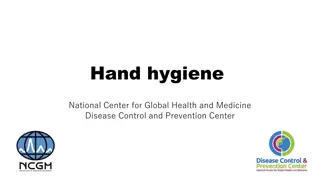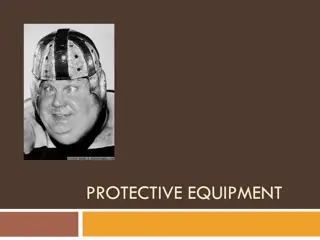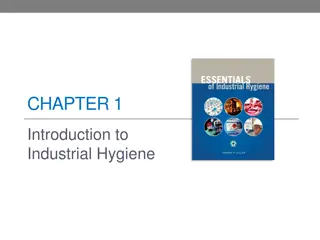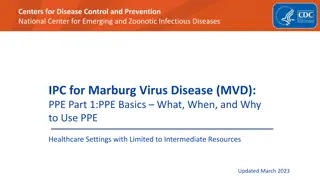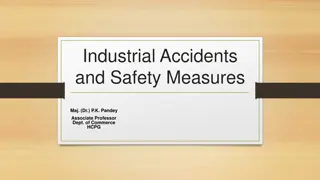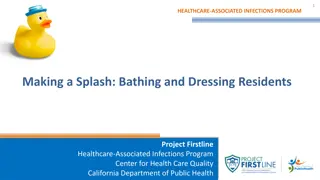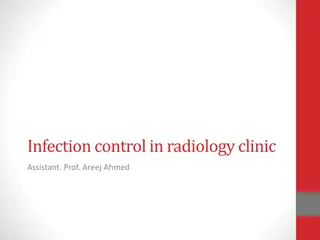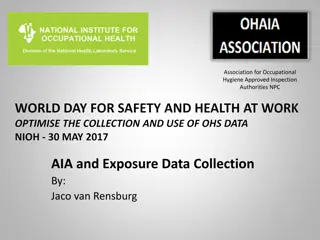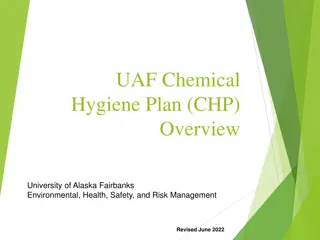Personal Protective Equipment Program in Industrial Hygiene
The chapter discusses the hierarchy of controls in industrial hygiene, with Personal Protective Equipment (PPE) being the least effective measure. It emphasizes the importance of a comprehensive PPE program, including hazard assessment, route identification, proper PPE selection, standard operating procedures development, and fitting PPE to workers for effective protection and comfort.
Download Presentation

Please find below an Image/Link to download the presentation.
The content on the website is provided AS IS for your information and personal use only. It may not be sold, licensed, or shared on other websites without obtaining consent from the author. Download presentation by click this link. If you encounter any issues during the download, it is possible that the publisher has removed the file from their server.
E N D
Presentation Transcript
Fundamentals of Industrial Hygiene 6thEdition Chapter 23: Personal Protective Equipment Compiled by David C. May, Associate Professor, Safety and Occupational Health Applied Sciences Keene State College
Hierarchy of Controls Most Effective Engineering Administrative Personal Protective Equipment Least Effective
Personal Protective Equipment Program To ensure that employees have appropriate PPE for each job task with hazards to mitigate risk Complexity of program varies with types of hazards and size of the organization Programs typically include the following nine elements
1 Hazard Assessment Job task analysis Identify each step Assess the magnitude of the hazard(s) at each step Include other workers that may be affected Determine if PPE is necessary as well as feasibility of engineering / administrative controls
Identify All Routes of Entry Consider all parts of the worker s body Inhalation Skin absorption Ocular Ingestion Injection (Source: NIOSH)
2 PPE Selection PPE must provide necessary protection not restrict the worker from doing the task Sufficient dexterity not create new hazards new hazards could include heat stress, ergonomic issues, communication interference, limited mobility, etc. provide a degree of comfort (so that it will be used)
3 Develop Standard Operating Procedures Typically written and includes: specificity of what PPE is required for what hazard and when it is to be used when replacement of PPE is necessary to prevent breakthrough or degradation care of PPE
4 Fitting PPE to the Worker Proper fit is critical for both effective protection and continued use. Adjustable size features should be identified and workers trained in the appropriate adjustments.
5 Training So workers know When to use PPE (which task or operation) The magnitude of the hazard and what PPE to use based on the hazard assessment How to inspect PPE for damage or non-functioning issues How to put it on and take it off (don and doff) When to replace the PPE How to check fit and effectiveness How to store and maintain when not in use
6 Maintenance of PPE Maintenance see manufacturer s recommendations Inspection wear and damage Storage to assure effectiveness when needed Cleaning to keep clean and sanitary (or alternatively use disposable PPE) Shelf life often specified by manufacturer
7 Employer Provided and Employee-Owned PPE Normally employers are required to provide/pay for PPE although OSHA allows some exceptions (non-specialty safety-toe footwear, etc.). Employers are also responsible for ensuring that employee-owned PPE meets necessary protection and prohibit its use when it is defective or unsanitary. (Source: OSHA)
8 Recordkeeping Additional records should be maintained for: PPE selection and worker training program Written certification for the workplace PPE/hazard assessment (required by OSHA)
Voluntary Use of PPE Includes situations where workers choose to utilize PPE even though its use is not required by the hazard assessment. Employer maintains the responsibility that PPE is used correctly and does not pose additional hazards.
9 Program Evaluation Annual evaluation based on: experience and accidents changes in work environment changes in PPE evaluation to assure PPE continues to provide necessary protection complaints and feedback from users
Specific Personal Protective Equipment
Eye and Face Protection Impact-resistant eyewear for protection against flying objects (chips and particles) marked with a plus sign (e.g., Z 87+ or Z 87-2+, if prescription) integral lateral protection (side shields) Reference: ANSI Z87.1
Eye and Face Dust and Chemicals Designed to give additional protection from dust or droplets typically utilizing a seal against the face Chemical face shield worn over spectacles Chemical goggles; marked as Splash and droplet protection (D3) Dust (D4) Fine dust (D5) Chemical face shield worn over goggles Full-face respirator Courtesy MSA
Eye and Face Optical Radiation Hazards Protect against infrared, ultraviolet and visible light Include direct or reflected light Marked W for welding, R for infrared, U for ultraviolet and L for visible light and glare Shade numbers indicate the optical density (Source: NIOSH)
Head Protection Type and Class ANSI Z89.1 Type I Impact or penetration protection from above Type II Additional protection from side, front, rear or off-center Class C (conductive but no electrical protection) Class G tested to 2,200 V Class E tested to 20,000 V Type 1, Class E Courtesy MSA
Head Protection Optional Features Reverse donning must be designed for that feature see manufacturer's literature High visibility choice Option for mounting for additional PPE: face shield, ear muffs, goggles, head-lamps, etc. Head protection with ear muffs
Head Protection Use Fitting Replace if damaged, cracked, chalked from UV (sun) exposure Decals, painting see manufacturer recommendations Service life of head protection see manufacturer recommendations
Foot Protection Electrical Hazards Electrical shock resistant shoes tested to14,000 V (dry conditions) Static dissipative some electrical shock protection Conductive footwear minimize the build-up of electrical charge See ASTM F1116, F1117
Foot Protection Design Options ASTM F-2412, F2413 Impact and compression resistant (toe caps) for falling or rolling objects. Protection against objects piercing the sole Chain saw cutting resistance ASTM F1458, F1818 Metatarsal protection Slip resistance
Hand Protection Hazards that potentially can be reduced by gloves/PPE abrasion temperature extremes puncture/cuts biological (infectious) electrical radiation vibration low visibility (where high reflectivity is needed) chemical
Hand Protection When choosing hand protection, consider: Size/fit Potential for glove material to be caught in machinery Loss of dexterity and tactile feedback Sensitization (e.g., latex) and dermatitis (from certain chemical accelerators used in rubber glove manufacture) Internal contamination resulting in occlusion of chemical against the skin Need to frequently assure protection integrity of the material (e.g., electrical gloves and sleeves)
Chemical-Protection Clothing/PPE Hazards of chemical contact potentially include: significant absorption hazard leading to systemic effects skin notation in ACGIH TLVs or OSHA PELs indicates dermal absorption warning tissue destruction (local effects) necrosis of tissue, e.g., corrosives, caustics dermal sensitivity (allergic dermatitis) includes chemicals with D-SEN notation in ACGIH TLVs Cement dermatitis (Source: NIOSH)
Chemical-Protection Clothing Decisions on type of protective clothing and the choice of material from which it is made depend on: job task requirements chemicals involved integration of other PPE potential to create additional hazards (ergonomic, heat stress)
Chemical-Protection Clothing (cont.) Effectiveness: No single material/fabric offers protection against all chemicals nor unlimited protection against any specific chemical Concerns: penetration of chemicals through clothing or ensemble mechanics such as through seams, zippers, stitching, etc. degradation damage caused by chemical on the fabric permeation of chemicals through fabric at molecular level
Chemical-Protection Clothing (cont.) Penetration of chemicals fabric seams provide varying amounts of protection depending on type of connection (stitched, cemented, heat sealed, etc.) Tape keeps seams or ensemble components in proper alignment some chemical-resistant tapes have been tested not appropriate for rip repairs on material/fabric
Chemical-Protection Clothing (cont.) Permeation: chemical specific Manufacturers permeation test typically measured by: Break-through detection time (hours) Permeation rate ( g/cm2/min) Cumulative break-through in 1 hour (gm or drops per hour) Permeation test cell
Levels of Protection Level Protective suit A Totally encapsulating, vapor-protective suit B Hooded chemical resistant clothing C Hooded chemical resistant clothing D Coveralls
PPE and Ionizing Radiation PPE must be able to reduce the penetration and the workers exposure to ionizing radiation by absorbing the energy in the PPE material. choice dependent on the type and magnitude of the radiation Not feasible for several types of radiation, e.g., high energy x-ray or gamma protection dependent on the density and thickness of the PPE material



